In-depth Report on Management Accounting Systems and Techniques
VerifiedAdded on 2023/01/12
|20
|6318
|57
Report
AI Summary
This report provides an in-depth analysis of management accounting (MA) systems and their essential requirements, focusing on Creams Ltd., an organization selling ice creams, doughnuts, and waffles. It explores various MA systems such as cost accounting, inventory management, job costing, and price optimization, detailing their benefits and applications. The report also discusses different MA reporting methods like job costing reports, inventory reports, operating budgets, and accounts receivable aging reports, highlighting their importance in evaluating company performance and managing cash flow. Furthermore, it examines various management accounting techniques and planning tools, weighing their advantages and disadvantages for establishing budgetary control. The report concludes with an analysis of how companies adapt their management accounting systems to improve efficiency and decision-making.
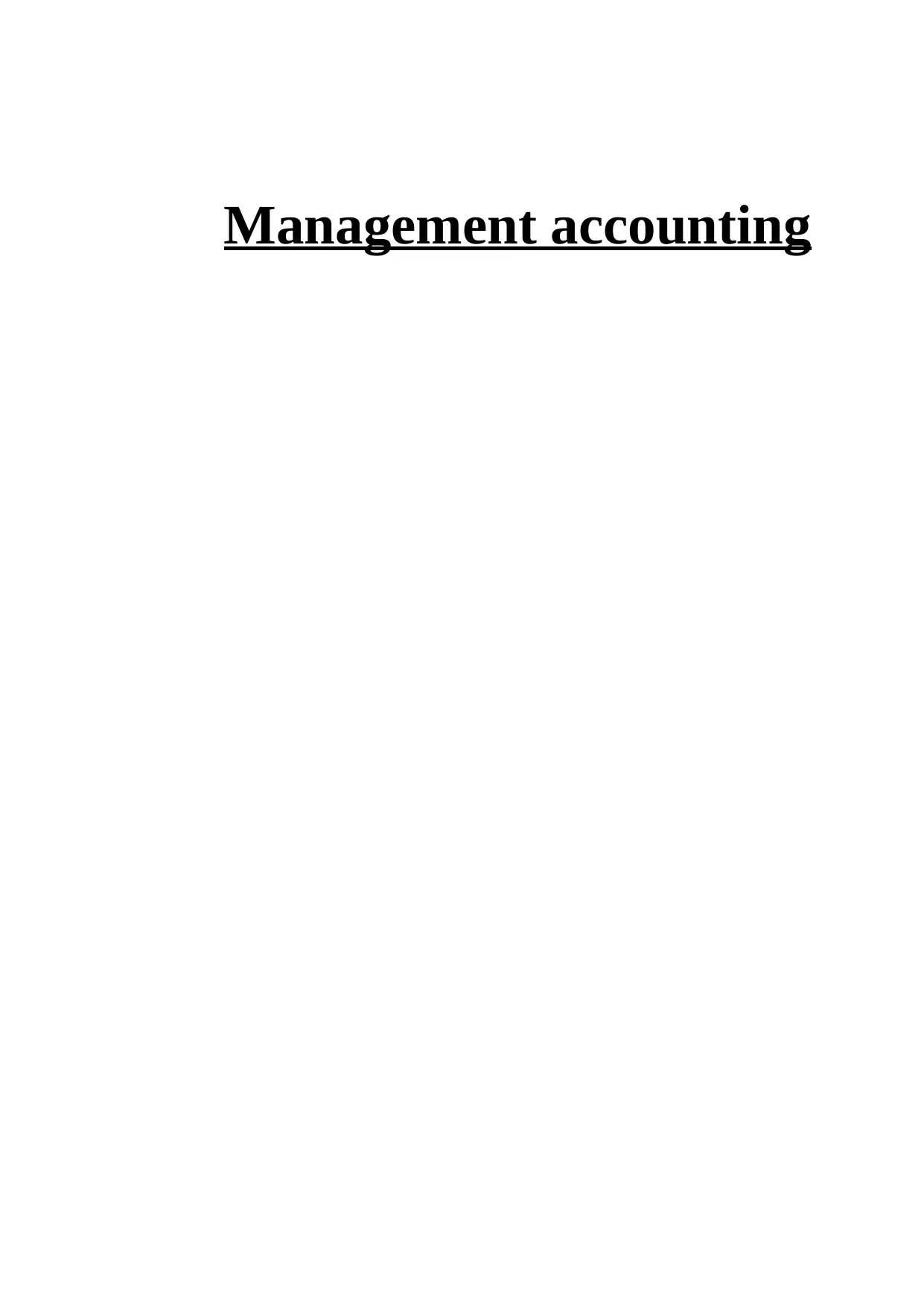
Management accounting
Paraphrase This Document
Need a fresh take? Get an instant paraphrase of this document with our AI Paraphraser

TABLE OF CONTENTS
INTRODUCTION......................................................................................................................3
LO1.............................................................................................................................................3
P1 Management accounting system and its essential requirements.......................................3
Difference between Financial and management Accounting.................................................6
P2 Different methods of MA reporting..................................................................................7
LO2.............................................................................................................................................9
P3 Management accounting techniques.................................................................................9
P4- Disadvantages and advantages of varied types of planning tools..................................12
P5- How companies are adapting management accounting systems...................................15
CONCLUSION........................................................................................................................16
REFERENCES.........................................................................................................................18
Bibliography-...........................................................................................................................19
INTRODUCTION......................................................................................................................3
LO1.............................................................................................................................................3
P1 Management accounting system and its essential requirements.......................................3
Difference between Financial and management Accounting.................................................6
P2 Different methods of MA reporting..................................................................................7
LO2.............................................................................................................................................9
P3 Management accounting techniques.................................................................................9
P4- Disadvantages and advantages of varied types of planning tools..................................12
P5- How companies are adapting management accounting systems...................................15
CONCLUSION........................................................................................................................16
REFERENCES.........................................................................................................................18
Bibliography-...........................................................................................................................19
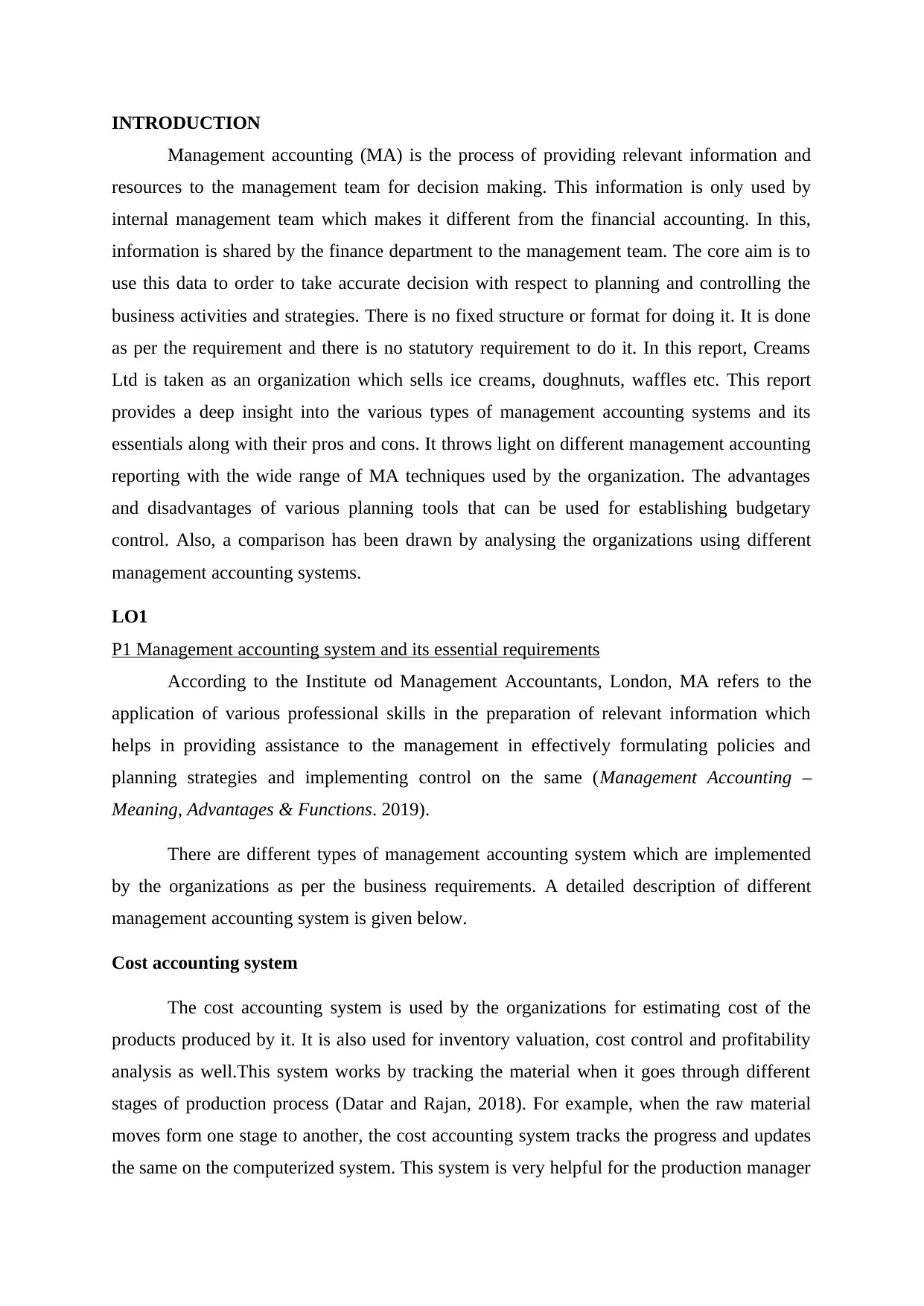
INTRODUCTION
Management accounting (MA) is the process of providing relevant information and
resources to the management team for decision making. This information is only used by
internal management team which makes it different from the financial accounting. In this,
information is shared by the finance department to the management team. The core aim is to
use this data to order to take accurate decision with respect to planning and controlling the
business activities and strategies. There is no fixed structure or format for doing it. It is done
as per the requirement and there is no statutory requirement to do it. In this report, Creams
Ltd is taken as an organization which sells ice creams, doughnuts, waffles etc. This report
provides a deep insight into the various types of management accounting systems and its
essentials along with their pros and cons. It throws light on different management accounting
reporting with the wide range of MA techniques used by the organization. The advantages
and disadvantages of various planning tools that can be used for establishing budgetary
control. Also, a comparison has been drawn by analysing the organizations using different
management accounting systems.
LO1
P1 Management accounting system and its essential requirements
According to the Institute od Management Accountants, London, MA refers to the
application of various professional skills in the preparation of relevant information which
helps in providing assistance to the management in effectively formulating policies and
planning strategies and implementing control on the same (Management Accounting –
Meaning, Advantages & Functions. 2019).
There are different types of management accounting system which are implemented
by the organizations as per the business requirements. A detailed description of different
management accounting system is given below.
Cost accounting system
The cost accounting system is used by the organizations for estimating cost of the
products produced by it. It is also used for inventory valuation, cost control and profitability
analysis as well.This system works by tracking the material when it goes through different
stages of production process (Datar and Rajan, 2018). For example, when the raw material
moves form one stage to another, the cost accounting system tracks the progress and updates
the same on the computerized system. This system is very helpful for the production manager
Management accounting (MA) is the process of providing relevant information and
resources to the management team for decision making. This information is only used by
internal management team which makes it different from the financial accounting. In this,
information is shared by the finance department to the management team. The core aim is to
use this data to order to take accurate decision with respect to planning and controlling the
business activities and strategies. There is no fixed structure or format for doing it. It is done
as per the requirement and there is no statutory requirement to do it. In this report, Creams
Ltd is taken as an organization which sells ice creams, doughnuts, waffles etc. This report
provides a deep insight into the various types of management accounting systems and its
essentials along with their pros and cons. It throws light on different management accounting
reporting with the wide range of MA techniques used by the organization. The advantages
and disadvantages of various planning tools that can be used for establishing budgetary
control. Also, a comparison has been drawn by analysing the organizations using different
management accounting systems.
LO1
P1 Management accounting system and its essential requirements
According to the Institute od Management Accountants, London, MA refers to the
application of various professional skills in the preparation of relevant information which
helps in providing assistance to the management in effectively formulating policies and
planning strategies and implementing control on the same (Management Accounting –
Meaning, Advantages & Functions. 2019).
There are different types of management accounting system which are implemented
by the organizations as per the business requirements. A detailed description of different
management accounting system is given below.
Cost accounting system
The cost accounting system is used by the organizations for estimating cost of the
products produced by it. It is also used for inventory valuation, cost control and profitability
analysis as well.This system works by tracking the material when it goes through different
stages of production process (Datar and Rajan, 2018). For example, when the raw material
moves form one stage to another, the cost accounting system tracks the progress and updates
the same on the computerized system. This system is very helpful for the production manager
⊘ This is a preview!⊘
Do you want full access?
Subscribe today to unlock all pages.

Trusted by 1+ million students worldwide
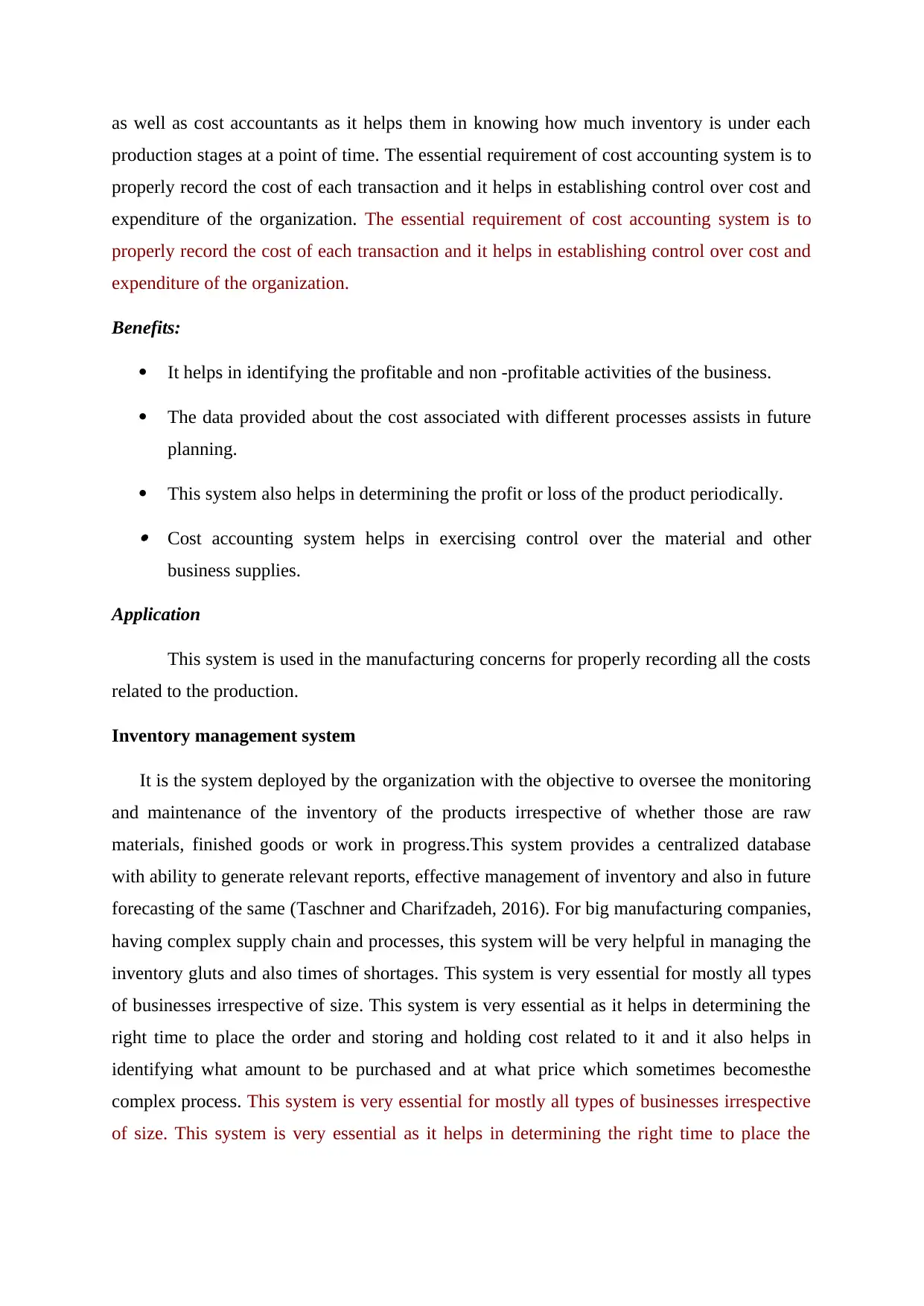
as well as cost accountants as it helps them in knowing how much inventory is under each
production stages at a point of time. The essential requirement of cost accounting system is to
properly record the cost of each transaction and it helps in establishing control over cost and
expenditure of the organization. The essential requirement of cost accounting system is to
properly record the cost of each transaction and it helps in establishing control over cost and
expenditure of the organization.
Benefits:
It helps in identifying the profitable and non -profitable activities of the business.
The data provided about the cost associated with different processes assists in future
planning.
This system also helps in determining the profit or loss of the product periodically. Cost accounting system helps in exercising control over the material and other
business supplies.
Application
This system is used in the manufacturing concerns for properly recording all the costs
related to the production.
Inventory management system
It is the system deployed by the organization with the objective to oversee the monitoring
and maintenance of the inventory of the products irrespective of whether those are raw
materials, finished goods or work in progress.This system provides a centralized database
with ability to generate relevant reports, effective management of inventory and also in future
forecasting of the same (Taschner and Charifzadeh, 2016). For big manufacturing companies,
having complex supply chain and processes, this system will be very helpful in managing the
inventory gluts and also times of shortages. This system is very essential for mostly all types
of businesses irrespective of size. This system is very essential as it helps in determining the
right time to place the order and storing and holding cost related to it and it also helps in
identifying what amount to be purchased and at what price which sometimes becomesthe
complex process. This system is very essential for mostly all types of businesses irrespective
of size. This system is very essential as it helps in determining the right time to place the
production stages at a point of time. The essential requirement of cost accounting system is to
properly record the cost of each transaction and it helps in establishing control over cost and
expenditure of the organization. The essential requirement of cost accounting system is to
properly record the cost of each transaction and it helps in establishing control over cost and
expenditure of the organization.
Benefits:
It helps in identifying the profitable and non -profitable activities of the business.
The data provided about the cost associated with different processes assists in future
planning.
This system also helps in determining the profit or loss of the product periodically. Cost accounting system helps in exercising control over the material and other
business supplies.
Application
This system is used in the manufacturing concerns for properly recording all the costs
related to the production.
Inventory management system
It is the system deployed by the organization with the objective to oversee the monitoring
and maintenance of the inventory of the products irrespective of whether those are raw
materials, finished goods or work in progress.This system provides a centralized database
with ability to generate relevant reports, effective management of inventory and also in future
forecasting of the same (Taschner and Charifzadeh, 2016). For big manufacturing companies,
having complex supply chain and processes, this system will be very helpful in managing the
inventory gluts and also times of shortages. This system is very essential for mostly all types
of businesses irrespective of size. This system is very essential as it helps in determining the
right time to place the order and storing and holding cost related to it and it also helps in
identifying what amount to be purchased and at what price which sometimes becomesthe
complex process. This system is very essential for mostly all types of businesses irrespective
of size. This system is very essential as it helps in determining the right time to place the
Paraphrase This Document
Need a fresh take? Get an instant paraphrase of this document with our AI Paraphraser
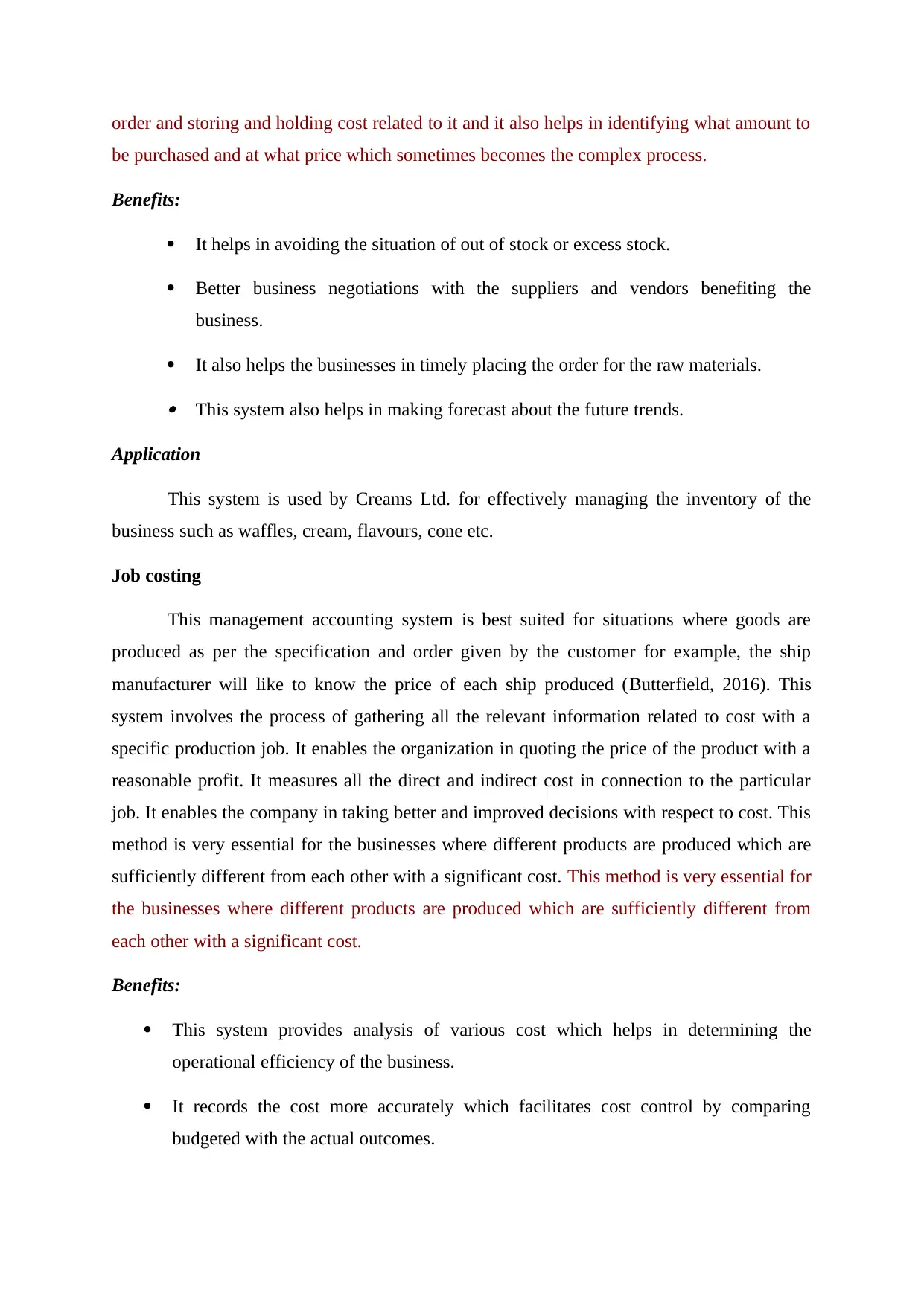
order and storing and holding cost related to it and it also helps in identifying what amount to
be purchased and at what price which sometimes becomes the complex process.
Benefits:
It helps in avoiding the situation of out of stock or excess stock.
Better business negotiations with the suppliers and vendors benefiting the
business.
It also helps the businesses in timely placing the order for the raw materials. This system also helps in making forecast about the future trends.
Application
This system is used by Creams Ltd. for effectively managing the inventory of the
business such as waffles, cream, flavours, cone etc.
Job costing
This management accounting system is best suited for situations where goods are
produced as per the specification and order given by the customer for example, the ship
manufacturer will like to know the price of each ship produced (Butterfield, 2016). This
system involves the process of gathering all the relevant information related to cost with a
specific production job. It enables the organization in quoting the price of the product with a
reasonable profit. It measures all the direct and indirect cost in connection to the particular
job. It enables the company in taking better and improved decisions with respect to cost. This
method is very essential for the businesses where different products are produced which are
sufficiently different from each other with a significant cost. This method is very essential for
the businesses where different products are produced which are sufficiently different from
each other with a significant cost.
Benefits:
This system provides analysis of various cost which helps in determining the
operational efficiency of the business.
It records the cost more accurately which facilitates cost control by comparing
budgeted with the actual outcomes.
be purchased and at what price which sometimes becomes the complex process.
Benefits:
It helps in avoiding the situation of out of stock or excess stock.
Better business negotiations with the suppliers and vendors benefiting the
business.
It also helps the businesses in timely placing the order for the raw materials. This system also helps in making forecast about the future trends.
Application
This system is used by Creams Ltd. for effectively managing the inventory of the
business such as waffles, cream, flavours, cone etc.
Job costing
This management accounting system is best suited for situations where goods are
produced as per the specification and order given by the customer for example, the ship
manufacturer will like to know the price of each ship produced (Butterfield, 2016). This
system involves the process of gathering all the relevant information related to cost with a
specific production job. It enables the organization in quoting the price of the product with a
reasonable profit. It measures all the direct and indirect cost in connection to the particular
job. It enables the company in taking better and improved decisions with respect to cost. This
method is very essential for the businesses where different products are produced which are
sufficiently different from each other with a significant cost. This method is very essential for
the businesses where different products are produced which are sufficiently different from
each other with a significant cost.
Benefits:
This system provides analysis of various cost which helps in determining the
operational efficiency of the business.
It records the cost more accurately which facilitates cost control by comparing
budgeted with the actual outcomes.
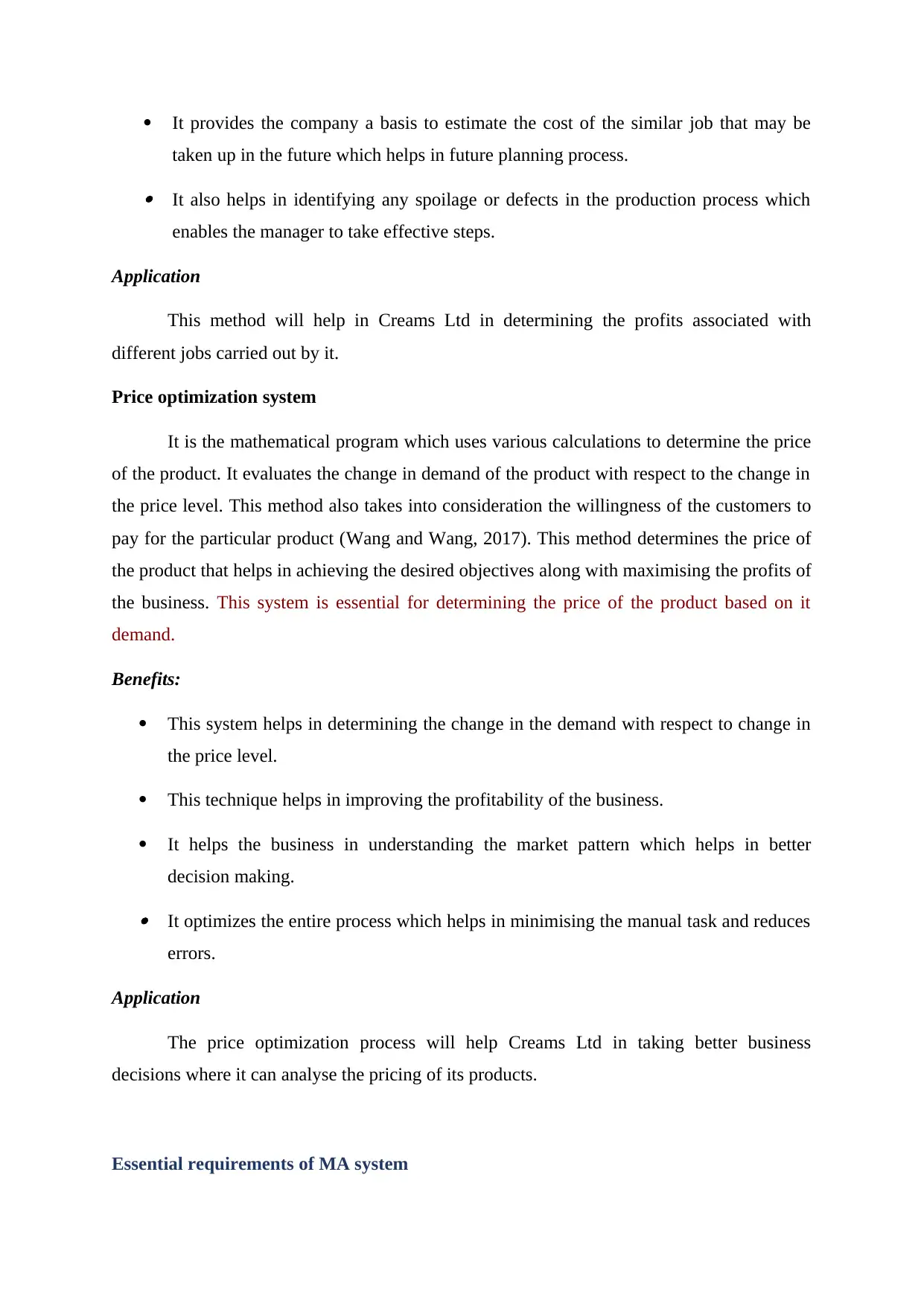
It provides the company a basis to estimate the cost of the similar job that may be
taken up in the future which helps in future planning process. It also helps in identifying any spoilage or defects in the production process which
enables the manager to take effective steps.
Application
This method will help in Creams Ltd in determining the profits associated with
different jobs carried out by it.
Price optimization system
It is the mathematical program which uses various calculations to determine the price
of the product. It evaluates the change in demand of the product with respect to the change in
the price level. This method also takes into consideration the willingness of the customers to
pay for the particular product (Wang and Wang, 2017). This method determines the price of
the product that helps in achieving the desired objectives along with maximising the profits of
the business. This system is essential for determining the price of the product based on it
demand.
Benefits:
This system helps in determining the change in the demand with respect to change in
the price level.
This technique helps in improving the profitability of the business.
It helps the business in understanding the market pattern which helps in better
decision making. It optimizes the entire process which helps in minimising the manual task and reduces
errors.
Application
The price optimization process will help Creams Ltd in taking better business
decisions where it can analyse the pricing of its products.
Essential requirements of MA system
taken up in the future which helps in future planning process. It also helps in identifying any spoilage or defects in the production process which
enables the manager to take effective steps.
Application
This method will help in Creams Ltd in determining the profits associated with
different jobs carried out by it.
Price optimization system
It is the mathematical program which uses various calculations to determine the price
of the product. It evaluates the change in demand of the product with respect to the change in
the price level. This method also takes into consideration the willingness of the customers to
pay for the particular product (Wang and Wang, 2017). This method determines the price of
the product that helps in achieving the desired objectives along with maximising the profits of
the business. This system is essential for determining the price of the product based on it
demand.
Benefits:
This system helps in determining the change in the demand with respect to change in
the price level.
This technique helps in improving the profitability of the business.
It helps the business in understanding the market pattern which helps in better
decision making. It optimizes the entire process which helps in minimising the manual task and reduces
errors.
Application
The price optimization process will help Creams Ltd in taking better business
decisions where it can analyse the pricing of its products.
Essential requirements of MA system
⊘ This is a preview!⊘
Do you want full access?
Subscribe today to unlock all pages.

Trusted by 1+ million students worldwide
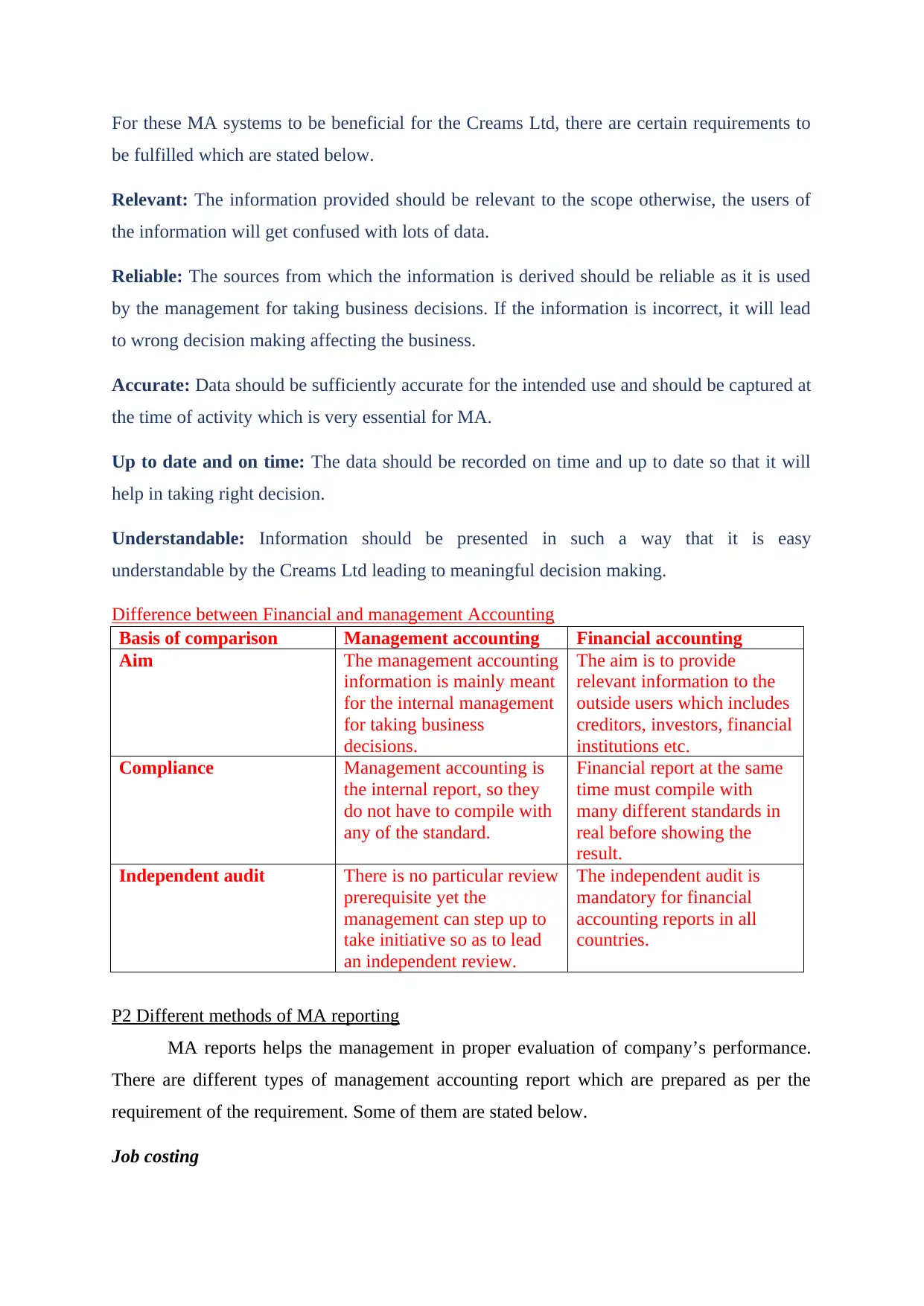
For these MA systems to be beneficial for the Creams Ltd, there are certain requirements to
be fulfilled which are stated below.
Relevant: The information provided should be relevant to the scope otherwise, the users of
the information will get confused with lots of data.
Reliable: The sources from which the information is derived should be reliable as it is used
by the management for taking business decisions. If the information is incorrect, it will lead
to wrong decision making affecting the business.
Accurate: Data should be sufficiently accurate for the intended use and should be captured at
the time of activity which is very essential for MA.
Up to date and on time: The data should be recorded on time and up to date so that it will
help in taking right decision.
Understandable: Information should be presented in such a way that it is easy
understandable by the Creams Ltd leading to meaningful decision making.
Difference between Financial and management Accounting
Basis of comparison Management accounting Financial accounting
Aim The management accounting
information is mainly meant
for the internal management
for taking business
decisions.
The aim is to provide
relevant information to the
outside users which includes
creditors, investors, financial
institutions etc.
Compliance Management accounting is
the internal report, so they
do not have to compile with
any of the standard.
Financial report at the same
time must compile with
many different standards in
real before showing the
result.
Independent audit There is no particular review
prerequisite yet the
management can step up to
take initiative so as to lead
an independent review.
The independent audit is
mandatory for financial
accounting reports in all
countries.
P2 Different methods of MA reporting
MA reports helps the management in proper evaluation of company’s performance.
There are different types of management accounting report which are prepared as per the
requirement of the requirement. Some of them are stated below.
Job costing
be fulfilled which are stated below.
Relevant: The information provided should be relevant to the scope otherwise, the users of
the information will get confused with lots of data.
Reliable: The sources from which the information is derived should be reliable as it is used
by the management for taking business decisions. If the information is incorrect, it will lead
to wrong decision making affecting the business.
Accurate: Data should be sufficiently accurate for the intended use and should be captured at
the time of activity which is very essential for MA.
Up to date and on time: The data should be recorded on time and up to date so that it will
help in taking right decision.
Understandable: Information should be presented in such a way that it is easy
understandable by the Creams Ltd leading to meaningful decision making.
Difference between Financial and management Accounting
Basis of comparison Management accounting Financial accounting
Aim The management accounting
information is mainly meant
for the internal management
for taking business
decisions.
The aim is to provide
relevant information to the
outside users which includes
creditors, investors, financial
institutions etc.
Compliance Management accounting is
the internal report, so they
do not have to compile with
any of the standard.
Financial report at the same
time must compile with
many different standards in
real before showing the
result.
Independent audit There is no particular review
prerequisite yet the
management can step up to
take initiative so as to lead
an independent review.
The independent audit is
mandatory for financial
accounting reports in all
countries.
P2 Different methods of MA reporting
MA reports helps the management in proper evaluation of company’s performance.
There are different types of management accounting report which are prepared as per the
requirement of the requirement. Some of them are stated below.
Job costing
Paraphrase This Document
Need a fresh take? Get an instant paraphrase of this document with our AI Paraphraser
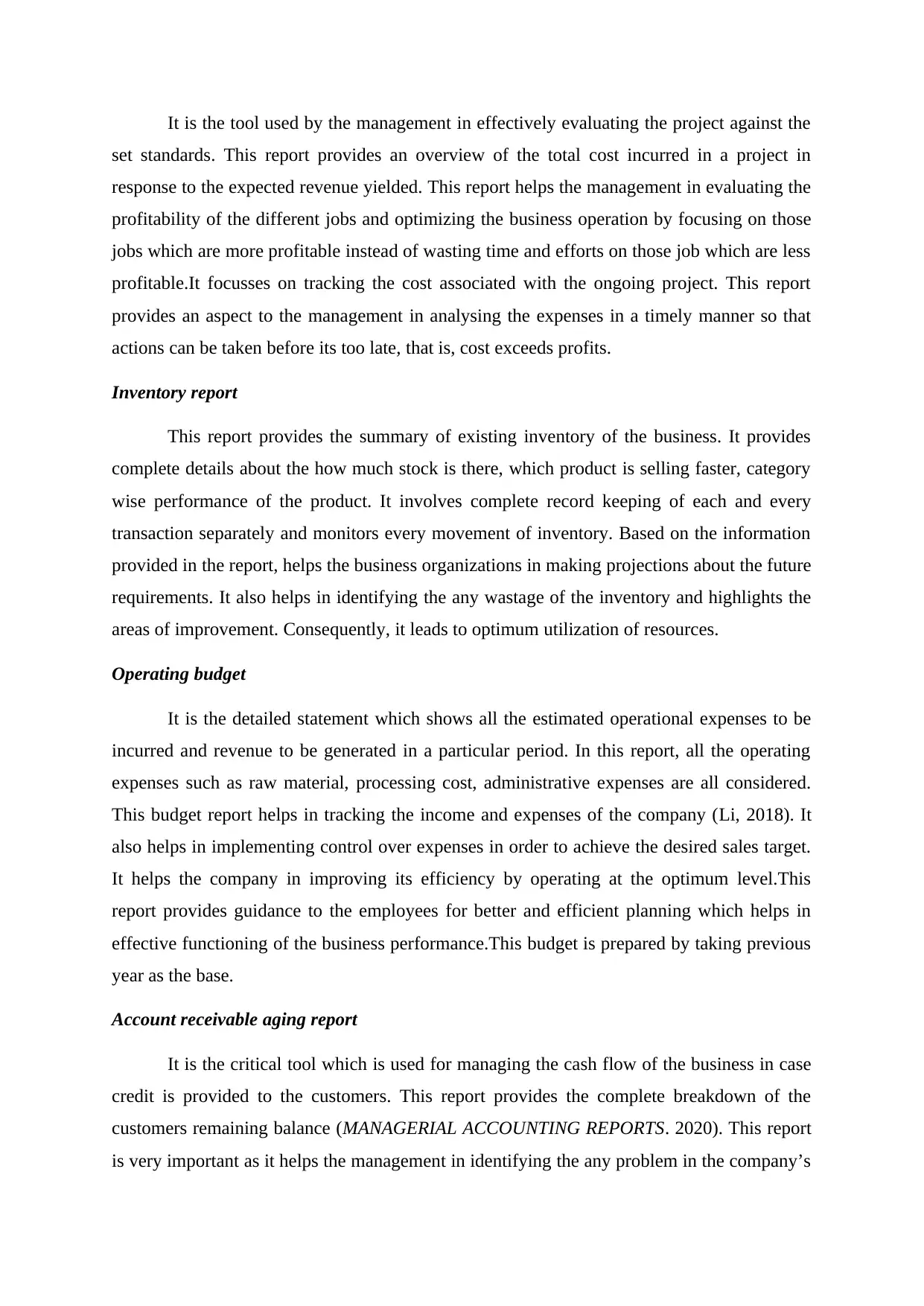
It is the tool used by the management in effectively evaluating the project against the
set standards. This report provides an overview of the total cost incurred in a project in
response to the expected revenue yielded. This report helps the management in evaluating the
profitability of the different jobs and optimizing the business operation by focusing on those
jobs which are more profitable instead of wasting time and efforts on those job which are less
profitable.It focusses on tracking the cost associated with the ongoing project. This report
provides an aspect to the management in analysing the expenses in a timely manner so that
actions can be taken before its too late, that is, cost exceeds profits.
Inventory report
This report provides the summary of existing inventory of the business. It provides
complete details about the how much stock is there, which product is selling faster, category
wise performance of the product. It involves complete record keeping of each and every
transaction separately and monitors every movement of inventory. Based on the information
provided in the report, helps the business organizations in making projections about the future
requirements. It also helps in identifying the any wastage of the inventory and highlights the
areas of improvement. Consequently, it leads to optimum utilization of resources.
Operating budget
It is the detailed statement which shows all the estimated operational expenses to be
incurred and revenue to be generated in a particular period. In this report, all the operating
expenses such as raw material, processing cost, administrative expenses are all considered.
This budget report helps in tracking the income and expenses of the company (Li, 2018). It
also helps in implementing control over expenses in order to achieve the desired sales target.
It helps the company in improving its efficiency by operating at the optimum level.This
report provides guidance to the employees for better and efficient planning which helps in
effective functioning of the business performance.This budget is prepared by taking previous
year as the base.
Account receivable aging report
It is the critical tool which is used for managing the cash flow of the business in case
credit is provided to the customers. This report provides the complete breakdown of the
customers remaining balance (MANAGERIAL ACCOUNTING REPORTS. 2020). This report
is very important as it helps the management in identifying the any problem in the company’s
set standards. This report provides an overview of the total cost incurred in a project in
response to the expected revenue yielded. This report helps the management in evaluating the
profitability of the different jobs and optimizing the business operation by focusing on those
jobs which are more profitable instead of wasting time and efforts on those job which are less
profitable.It focusses on tracking the cost associated with the ongoing project. This report
provides an aspect to the management in analysing the expenses in a timely manner so that
actions can be taken before its too late, that is, cost exceeds profits.
Inventory report
This report provides the summary of existing inventory of the business. It provides
complete details about the how much stock is there, which product is selling faster, category
wise performance of the product. It involves complete record keeping of each and every
transaction separately and monitors every movement of inventory. Based on the information
provided in the report, helps the business organizations in making projections about the future
requirements. It also helps in identifying the any wastage of the inventory and highlights the
areas of improvement. Consequently, it leads to optimum utilization of resources.
Operating budget
It is the detailed statement which shows all the estimated operational expenses to be
incurred and revenue to be generated in a particular period. In this report, all the operating
expenses such as raw material, processing cost, administrative expenses are all considered.
This budget report helps in tracking the income and expenses of the company (Li, 2018). It
also helps in implementing control over expenses in order to achieve the desired sales target.
It helps the company in improving its efficiency by operating at the optimum level.This
report provides guidance to the employees for better and efficient planning which helps in
effective functioning of the business performance.This budget is prepared by taking previous
year as the base.
Account receivable aging report
It is the critical tool which is used for managing the cash flow of the business in case
credit is provided to the customers. This report provides the complete breakdown of the
customers remaining balance (MANAGERIAL ACCOUNTING REPORTS. 2020). This report
is very important as it helps the management in identifying the any problem in the company’s
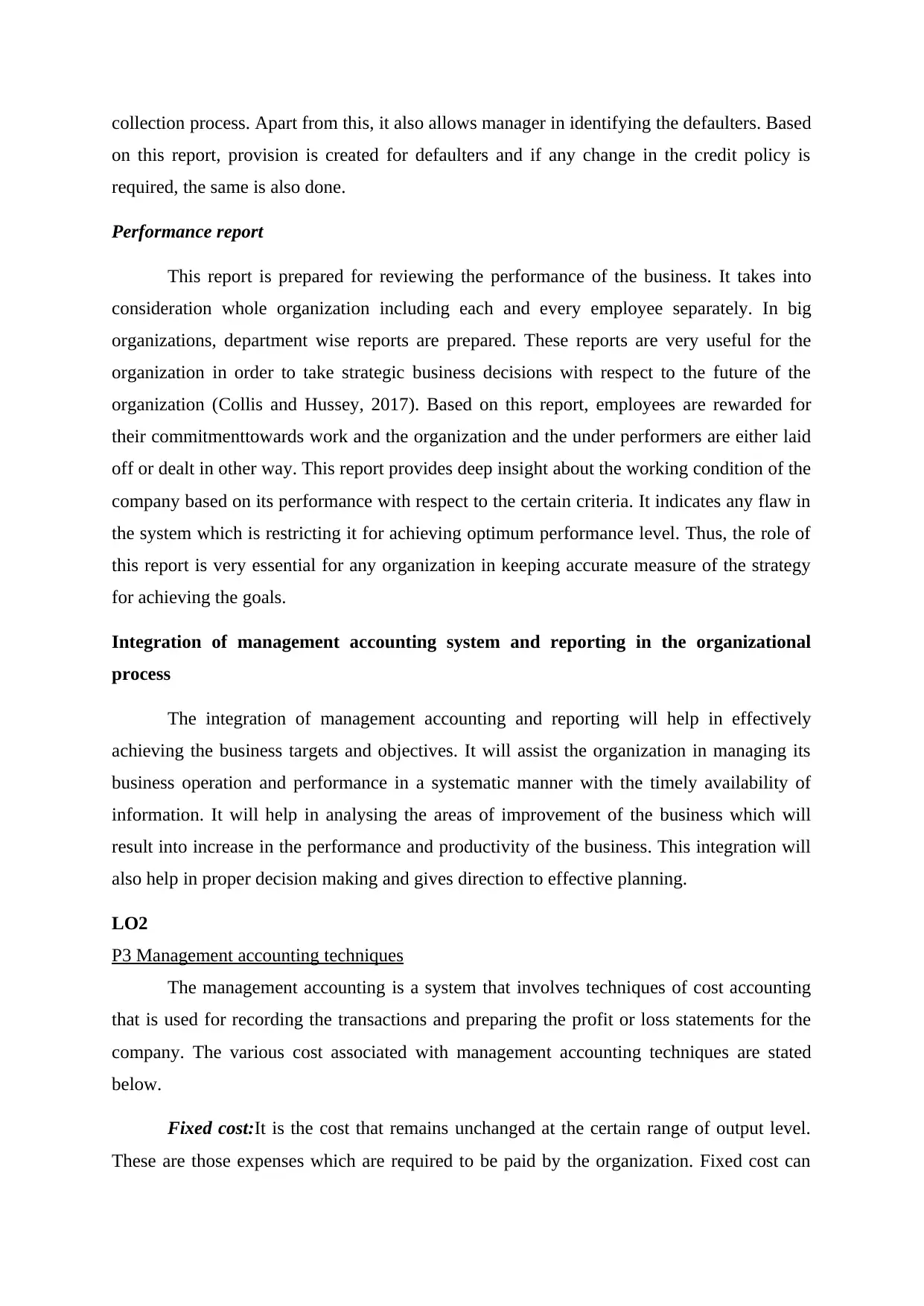
collection process. Apart from this, it also allows manager in identifying the defaulters. Based
on this report, provision is created for defaulters and if any change in the credit policy is
required, the same is also done.
Performance report
This report is prepared for reviewing the performance of the business. It takes into
consideration whole organization including each and every employee separately. In big
organizations, department wise reports are prepared. These reports are very useful for the
organization in order to take strategic business decisions with respect to the future of the
organization (Collis and Hussey, 2017). Based on this report, employees are rewarded for
their commitmenttowards work and the organization and the under performers are either laid
off or dealt in other way. This report provides deep insight about the working condition of the
company based on its performance with respect to the certain criteria. It indicates any flaw in
the system which is restricting it for achieving optimum performance level. Thus, the role of
this report is very essential for any organization in keeping accurate measure of the strategy
for achieving the goals.
Integration of management accounting system and reporting in the organizational
process
The integration of management accounting and reporting will help in effectively
achieving the business targets and objectives. It will assist the organization in managing its
business operation and performance in a systematic manner with the timely availability of
information. It will help in analysing the areas of improvement of the business which will
result into increase in the performance and productivity of the business. This integration will
also help in proper decision making and gives direction to effective planning.
LO2
P3 Management accounting techniques
The management accounting is a system that involves techniques of cost accounting
that is used for recording the transactions and preparing the profit or loss statements for the
company. The various cost associated with management accounting techniques are stated
below.
Fixed cost:It is the cost that remains unchanged at the certain range of output level.
These are those expenses which are required to be paid by the organization. Fixed cost can
on this report, provision is created for defaulters and if any change in the credit policy is
required, the same is also done.
Performance report
This report is prepared for reviewing the performance of the business. It takes into
consideration whole organization including each and every employee separately. In big
organizations, department wise reports are prepared. These reports are very useful for the
organization in order to take strategic business decisions with respect to the future of the
organization (Collis and Hussey, 2017). Based on this report, employees are rewarded for
their commitmenttowards work and the organization and the under performers are either laid
off or dealt in other way. This report provides deep insight about the working condition of the
company based on its performance with respect to the certain criteria. It indicates any flaw in
the system which is restricting it for achieving optimum performance level. Thus, the role of
this report is very essential for any organization in keeping accurate measure of the strategy
for achieving the goals.
Integration of management accounting system and reporting in the organizational
process
The integration of management accounting and reporting will help in effectively
achieving the business targets and objectives. It will assist the organization in managing its
business operation and performance in a systematic manner with the timely availability of
information. It will help in analysing the areas of improvement of the business which will
result into increase in the performance and productivity of the business. This integration will
also help in proper decision making and gives direction to effective planning.
LO2
P3 Management accounting techniques
The management accounting is a system that involves techniques of cost accounting
that is used for recording the transactions and preparing the profit or loss statements for the
company. The various cost associated with management accounting techniques are stated
below.
Fixed cost:It is the cost that remains unchanged at the certain range of output level.
These are those expenses which are required to be paid by the organization. Fixed cost can
⊘ This is a preview!⊘
Do you want full access?
Subscribe today to unlock all pages.

Trusted by 1+ million students worldwide
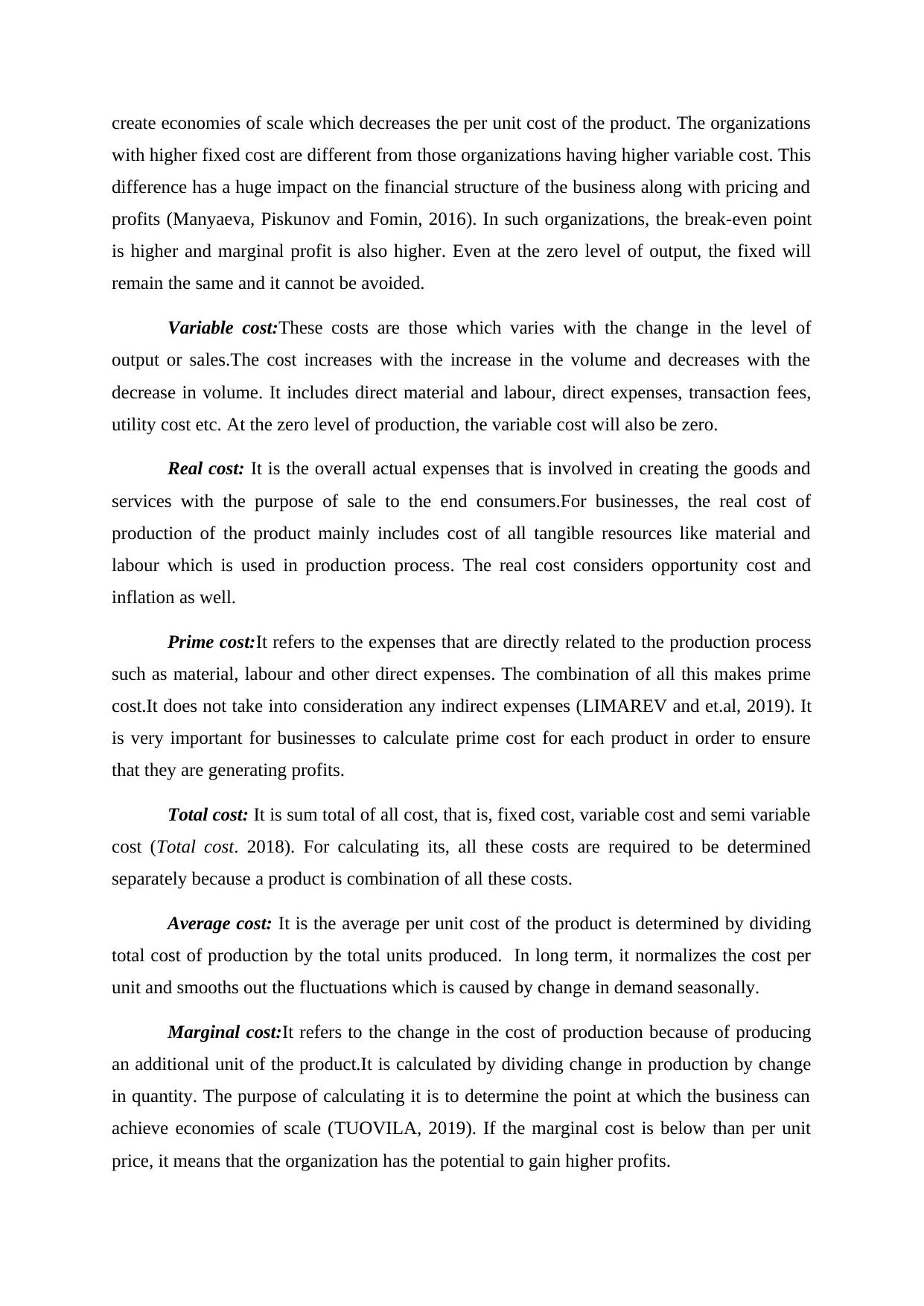
create economies of scale which decreases the per unit cost of the product. The organizations
with higher fixed cost are different from those organizations having higher variable cost. This
difference has a huge impact on the financial structure of the business along with pricing and
profits (Manyaeva, Piskunov and Fomin, 2016). In such organizations, the break-even point
is higher and marginal profit is also higher. Even at the zero level of output, the fixed will
remain the same and it cannot be avoided.
Variable cost:These costs are those which varies with the change in the level of
output or sales.The cost increases with the increase in the volume and decreases with the
decrease in volume. It includes direct material and labour, direct expenses, transaction fees,
utility cost etc. At the zero level of production, the variable cost will also be zero.
Real cost: It is the overall actual expenses that is involved in creating the goods and
services with the purpose of sale to the end consumers.For businesses, the real cost of
production of the product mainly includes cost of all tangible resources like material and
labour which is used in production process. The real cost considers opportunity cost and
inflation as well.
Prime cost:It refers to the expenses that are directly related to the production process
such as material, labour and other direct expenses. The combination of all this makes prime
cost.It does not take into consideration any indirect expenses (LIMAREV and et.al, 2019). It
is very important for businesses to calculate prime cost for each product in order to ensure
that they are generating profits.
Total cost: It is sum total of all cost, that is, fixed cost, variable cost and semi variable
cost (Total cost. 2018). For calculating its, all these costs are required to be determined
separately because a product is combination of all these costs.
Average cost: It is the average per unit cost of the product is determined by dividing
total cost of production by the total units produced. In long term, it normalizes the cost per
unit and smooths out the fluctuations which is caused by change in demand seasonally.
Marginal cost:It refers to the change in the cost of production because of producing
an additional unit of the product.It is calculated by dividing change in production by change
in quantity. The purpose of calculating it is to determine the point at which the business can
achieve economies of scale (TUOVILA, 2019). If the marginal cost is below than per unit
price, it means that the organization has the potential to gain higher profits.
with higher fixed cost are different from those organizations having higher variable cost. This
difference has a huge impact on the financial structure of the business along with pricing and
profits (Manyaeva, Piskunov and Fomin, 2016). In such organizations, the break-even point
is higher and marginal profit is also higher. Even at the zero level of output, the fixed will
remain the same and it cannot be avoided.
Variable cost:These costs are those which varies with the change in the level of
output or sales.The cost increases with the increase in the volume and decreases with the
decrease in volume. It includes direct material and labour, direct expenses, transaction fees,
utility cost etc. At the zero level of production, the variable cost will also be zero.
Real cost: It is the overall actual expenses that is involved in creating the goods and
services with the purpose of sale to the end consumers.For businesses, the real cost of
production of the product mainly includes cost of all tangible resources like material and
labour which is used in production process. The real cost considers opportunity cost and
inflation as well.
Prime cost:It refers to the expenses that are directly related to the production process
such as material, labour and other direct expenses. The combination of all this makes prime
cost.It does not take into consideration any indirect expenses (LIMAREV and et.al, 2019). It
is very important for businesses to calculate prime cost for each product in order to ensure
that they are generating profits.
Total cost: It is sum total of all cost, that is, fixed cost, variable cost and semi variable
cost (Total cost. 2018). For calculating its, all these costs are required to be determined
separately because a product is combination of all these costs.
Average cost: It is the average per unit cost of the product is determined by dividing
total cost of production by the total units produced. In long term, it normalizes the cost per
unit and smooths out the fluctuations which is caused by change in demand seasonally.
Marginal cost:It refers to the change in the cost of production because of producing
an additional unit of the product.It is calculated by dividing change in production by change
in quantity. The purpose of calculating it is to determine the point at which the business can
achieve economies of scale (TUOVILA, 2019). If the marginal cost is below than per unit
price, it means that the organization has the potential to gain higher profits.
Paraphrase This Document
Need a fresh take? Get an instant paraphrase of this document with our AI Paraphraser
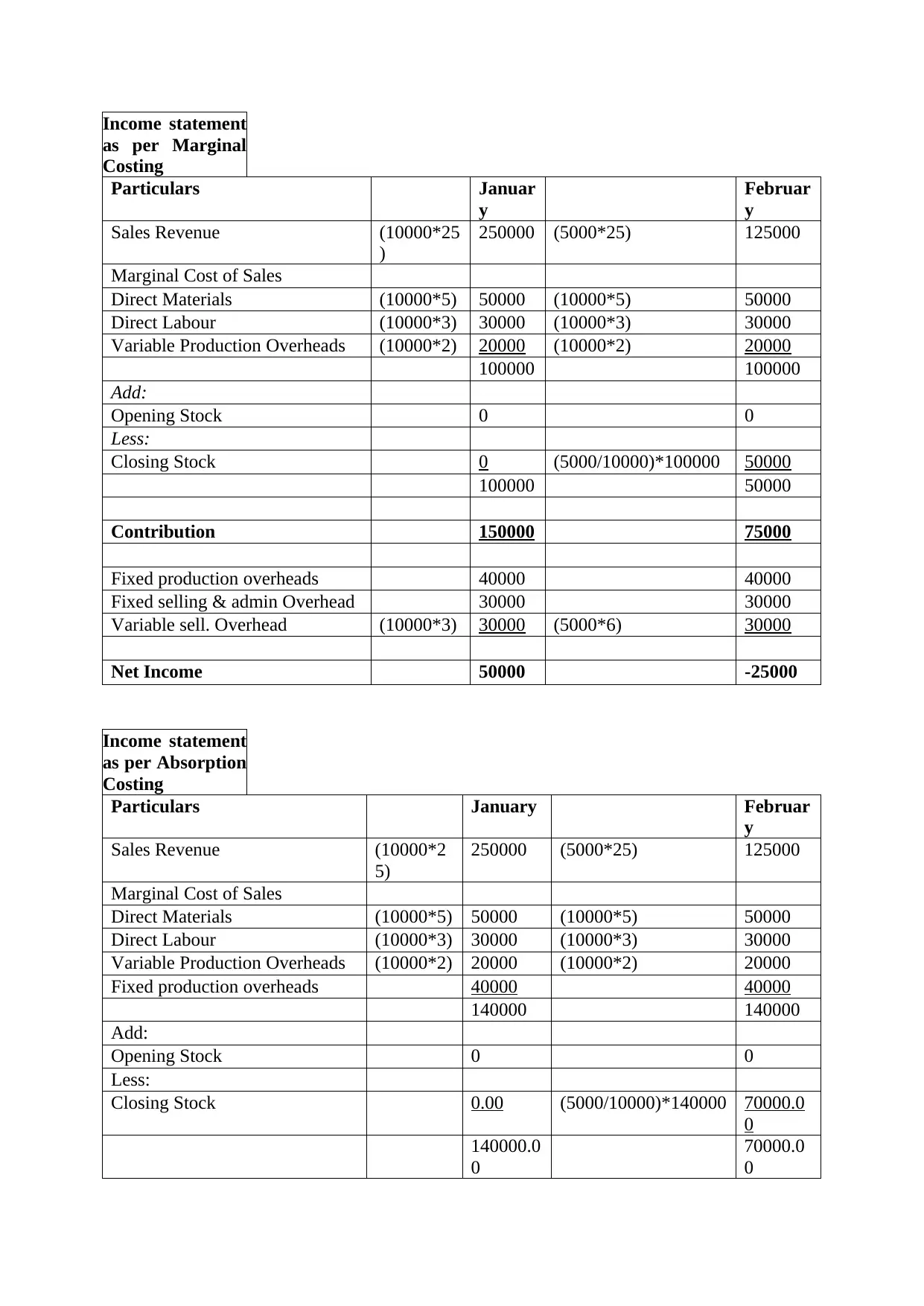
Income statement
as per Marginal
Costing
Particulars Januar
y
Februar
y
Sales Revenue (10000*25
)
250000 (5000*25) 125000
Marginal Cost of Sales
Direct Materials (10000*5) 50000 (10000*5) 50000
Direct Labour (10000*3) 30000 (10000*3) 30000
Variable Production Overheads (10000*2) 20000 (10000*2) 20000
100000 100000
Add:
Opening Stock 0 0
Less:
Closing Stock 0 (5000/10000)*100000 50000
100000 50000
Contribution 150000 75000
Fixed production overheads 40000 40000
Fixed selling & admin Overhead 30000 30000
Variable sell. Overhead (10000*3) 30000 (5000*6) 30000
Net Income 50000 -25000
Income statement
as per Absorption
Costing
Particulars January Februar
y
Sales Revenue (10000*2
5)
250000 (5000*25) 125000
Marginal Cost of Sales
Direct Materials (10000*5) 50000 (10000*5) 50000
Direct Labour (10000*3) 30000 (10000*3) 30000
Variable Production Overheads (10000*2) 20000 (10000*2) 20000
Fixed production overheads 40000 40000
140000 140000
Add:
Opening Stock 0 0
Less:
Closing Stock 0.00 (5000/10000)*140000 70000.0
0
140000.0
0
70000.0
0
as per Marginal
Costing
Particulars Januar
y
Februar
y
Sales Revenue (10000*25
)
250000 (5000*25) 125000
Marginal Cost of Sales
Direct Materials (10000*5) 50000 (10000*5) 50000
Direct Labour (10000*3) 30000 (10000*3) 30000
Variable Production Overheads (10000*2) 20000 (10000*2) 20000
100000 100000
Add:
Opening Stock 0 0
Less:
Closing Stock 0 (5000/10000)*100000 50000
100000 50000
Contribution 150000 75000
Fixed production overheads 40000 40000
Fixed selling & admin Overhead 30000 30000
Variable sell. Overhead (10000*3) 30000 (5000*6) 30000
Net Income 50000 -25000
Income statement
as per Absorption
Costing
Particulars January Februar
y
Sales Revenue (10000*2
5)
250000 (5000*25) 125000
Marginal Cost of Sales
Direct Materials (10000*5) 50000 (10000*5) 50000
Direct Labour (10000*3) 30000 (10000*3) 30000
Variable Production Overheads (10000*2) 20000 (10000*2) 20000
Fixed production overheads 40000 40000
140000 140000
Add:
Opening Stock 0 0
Less:
Closing Stock 0.00 (5000/10000)*140000 70000.0
0
140000.0
0
70000.0
0
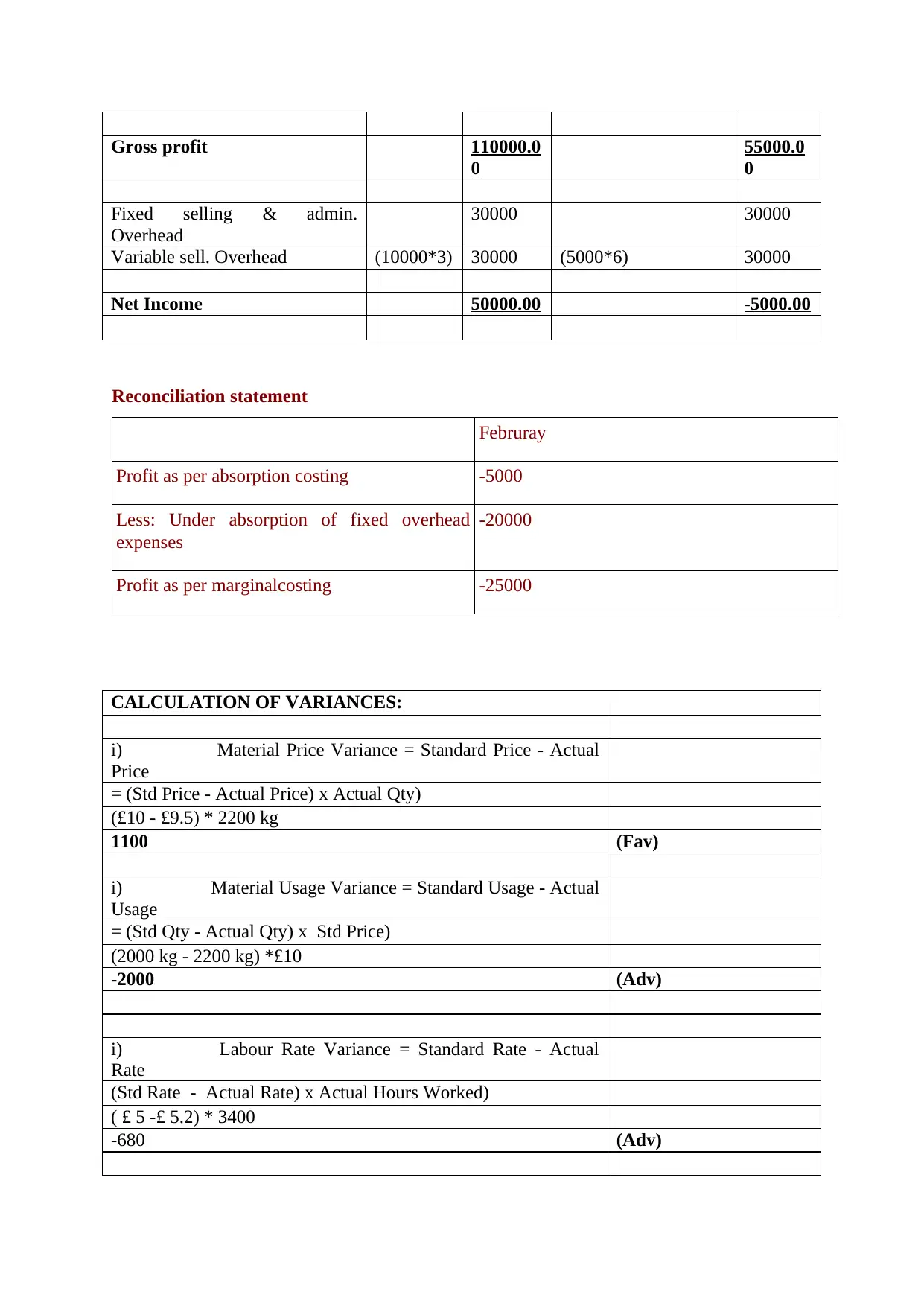
Gross profit 110000.0
0
55000.0
0
Fixed selling & admin.
Overhead
30000 30000
Variable sell. Overhead (10000*3) 30000 (5000*6) 30000
Net Income 50000.00 -5000.00
Reconciliation statement
Februray
Profit as per absorption costing -5000
Less: Under absorption of fixed overhead
expenses
-20000
Profit as per marginalcosting -25000
CALCULATION OF VARIANCES:
i) Material Price Variance = Standard Price - Actual
Price
= (Std Price - Actual Price) x Actual Qty)
(£10 - £9.5) * 2200 kg
1100 (Fav)
i) Material Usage Variance = Standard Usage - Actual
Usage
= (Std Qty - Actual Qty) x Std Price)
(2000 kg - 2200 kg) *£10
-2000 (Adv)
i) Labour Rate Variance = Standard Rate - Actual
Rate
(Std Rate - Actual Rate) x Actual Hours Worked)
( £ 5 -£ 5.2) * 3400
-680 (Adv)
0
55000.0
0
Fixed selling & admin.
Overhead
30000 30000
Variable sell. Overhead (10000*3) 30000 (5000*6) 30000
Net Income 50000.00 -5000.00
Reconciliation statement
Februray
Profit as per absorption costing -5000
Less: Under absorption of fixed overhead
expenses
-20000
Profit as per marginalcosting -25000
CALCULATION OF VARIANCES:
i) Material Price Variance = Standard Price - Actual
Price
= (Std Price - Actual Price) x Actual Qty)
(£10 - £9.5) * 2200 kg
1100 (Fav)
i) Material Usage Variance = Standard Usage - Actual
Usage
= (Std Qty - Actual Qty) x Std Price)
(2000 kg - 2200 kg) *£10
-2000 (Adv)
i) Labour Rate Variance = Standard Rate - Actual
Rate
(Std Rate - Actual Rate) x Actual Hours Worked)
( £ 5 -£ 5.2) * 3400
-680 (Adv)
⊘ This is a preview!⊘
Do you want full access?
Subscribe today to unlock all pages.

Trusted by 1+ million students worldwide
1 out of 20
Related Documents
Your All-in-One AI-Powered Toolkit for Academic Success.
+13062052269
info@desklib.com
Available 24*7 on WhatsApp / Email
![[object Object]](/_next/static/media/star-bottom.7253800d.svg)
Unlock your academic potential
Copyright © 2020–2025 A2Z Services. All Rights Reserved. Developed and managed by ZUCOL.




